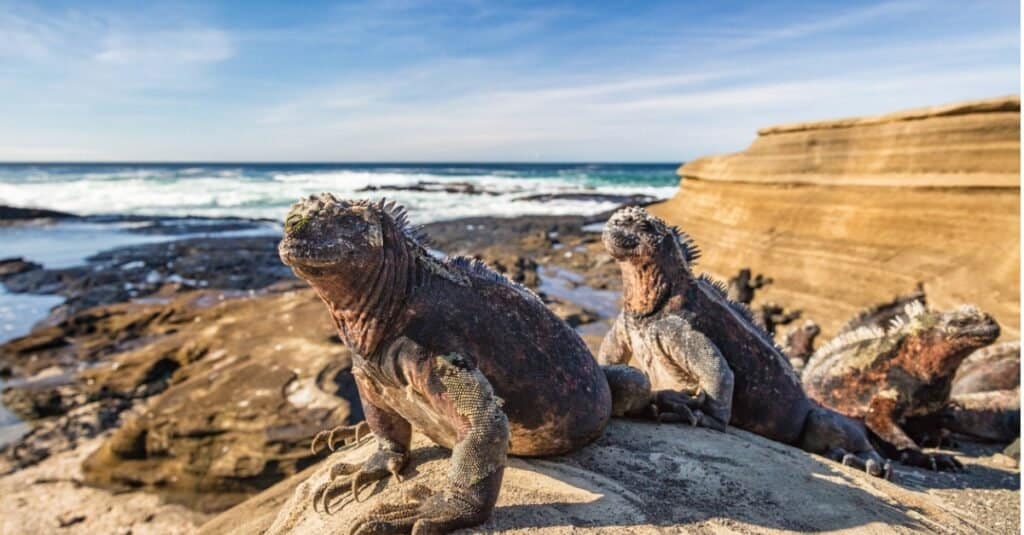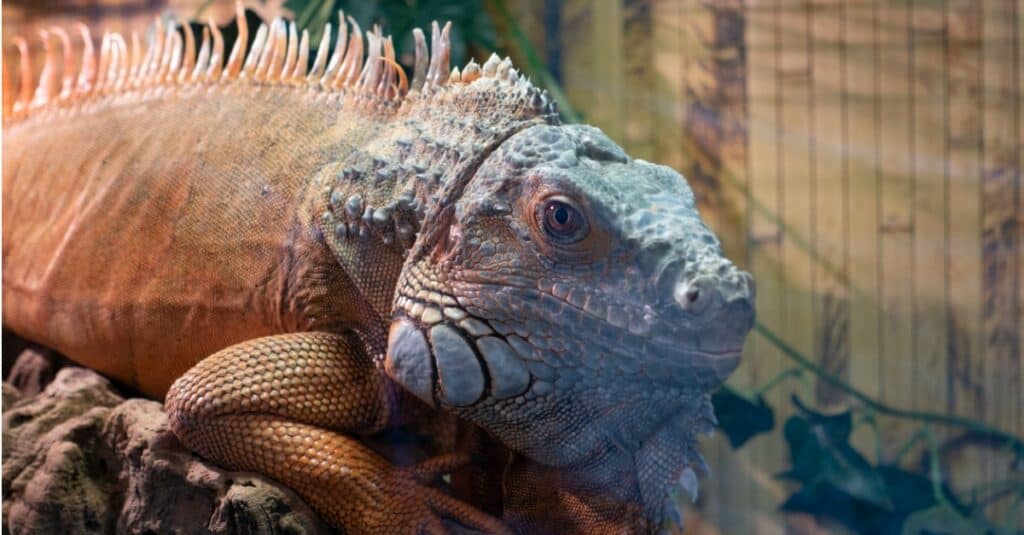One trait most iguana species have in common is their surprisingly long lifespans, especially when compared to other reptiles like smaller lizards, snakes, and tortoises. There are more than 40 unique species within the Iguanidae suborder, and their lifespans vary significantly, from as short as 3 years to up to 70 years. However, exactly how long iguanas live depends on a lot more than just their species!
In fact, a wide range of factors, such as whether an iguana grows up in the wild or is raised in captivity, their diet, genetics, and more can all play an important role in how long they live. Read on as we explore various iguana species’ lifespans both in the wild and as pets below!
How Long Do Iguanas Live in the Wild?

Iguana species can live from 3 to 50+ years of age.
©iStock.com/passion4nature
Overall, wild iguanas, depending on the species, can live anywhere from as little as 3 years to 50+ years. It should be noted that as a general rule, most reptiles live a lot longer in captivity than they do in the wild. This is because captive reptiles – in this case, iguanas – are typically housed in enclosures with very carefully controlled conditions.
Typically, the smaller the iguana is, the shorter their lifespan is both in the wild and in captivity. For example, the diminutive Fiji banded iguana tends to live for only around 10 to 15 years in the wild. The desert iguana, another fairly small species, only lives for around 5 to 10 years at most in the wild. Meanwhile, the much larger Grand Cayman blue iguana is capable of living for well over 40 years! This is impressive, especially in their natural habitat with no human intervention or assistance!
On average, though, the majority of iguana species live for somewhere between 10 to 25 years in the wild. For instance, the green iguana, one of the largest, most abundant, and most well-known species, usually lives for around 10 to 15 years in the wild. However, as we’ll cover in more detail soon, their lifespans can be greatly extended in captivity with proper husbandry.
Size and species are far from the only factors determining a wild iguana’s lifespan, though. Next, we’ll break down these factors in detail to give you a more nuanced understanding of why wild iguanas have it rough in their native habitats compared to captive individuals.
What Factors Affect Wild Iguana Lifespans?

Wild iguanas like these
marine iguanas
have to deal with stressors like food scarcity, temperature fluctuations, and lack of access to veterinary care.
©iStock.com/Maridav
When it comes to captive reptiles, their lifespans are easy to accurately estimate. This is mostly because they usually live in very carefully maintained and controlled enclosures. Things like temperature, humidity, food, medical care, and more are typically accounted for. As a result, captive iguanas don’t need to expend a lot of energy on survival like those in the wild.
Wild iguanas, on the other hand, have to deal with a variety of unpredictable factors, including:
- Predation
- Food scarcity
- Temperature and humidity fluctuations
- Genetic disabilities, deformities, and illnesses (Note: Reptile breeders usually only breed captive reptiles with “favorable” genetics to ensure longer lifespans and healthier animals in general. Wild iguanas are not nearly as selective.)
- Inclement weather (heavy rain, hurricanes, tornadoes, tsunamis, etc.)
- Lack of treatment for illnesses or injuries
- Chronic stress caused by the above factors
As a result, wild iguanas can have drastically shortened lifespans compared to captive individuals. Over time, these combined stressors of natural selection can take a toll on a wild iggy’s health.
What’s more, they don’t have guaranteed access to veterinary care if they do become ill or injured due to the above factors. This means even the most minor illnesses and injuries can very quickly kill an iguana living in their native habitat.
How Long Do Pet Iguanas Live?

Captive iguanas typically live significantly longer than those in the wild, in part due to their carefully maintained enclosures.
©iStock.com/Chepko
As we touched on earlier, captive iguanas (i.e. those kept in zoos or as pets) live much longer than their wild counterparts. In general, captive iguanas can live for anywhere from 5 to 60+ years, depending on their species, genetics, and the quality of their care.
Remember the Grand Cayman blue iguanas I mentioned earlier? Although they tend to only live for around 20 to 40 years in the wild, these handsome lizards can live incredibly long lives in captivity! In fact, one individual known as “Godzilla” at Gladys Porter Zoo in Brownsville, Texas, lived for nearly 70 years! Many researchers even believe Godzilla could be the longest-living lizard in history, but records on reptile lifespans aren’t very well documented.
Other species of iguanas commonly kept as pets, like green iguanas and spiny-tailed iguanas, can live for well over 30 years with proper husbandry. On average, though, their lifespans are usually somewhere between 15 and 25 years in captivity.
Additionally, Guinness World Records recently confirmed that a rhinoceros iguana owned by the legendary Steve Irwin’s family has lived for a whopping 40 years (and counting)! Currently, the iguana, named Rhino, is still alive and thriving at the Australia Zoo (also owned by Irwin’s family). Rhino is now approaching his 41st birthday!
What Factors Affect Pet Iguana Lifespans?

Iguanas in captivity typically have more nutritious diets than those in the wild.
©iStock.com/Mladich
Similar to how many factors can negatively impact a wild iguana’s lifespan, there are just as many that can positively affect a captive iguana’s longevity. These factors include:
- Healthier, more nutritious diets
- Lower risk of parasites and other health conditions
- Carefully controlled humidity and temperature within their enclosures
- Lack of predation
- Access to shelter from inclement weather
- Better access to veterinary care for illnesses and injuries
- Overall better genetics (again, since reptile breeders usually breed reptiles with healthier/more “favorable” traits)
- Overall lower stress due to less external stressors
In short, captive iguanas live significantly longer on average than wild iguanas. This is mainly because captive iguanas don’t have to worry about, for example, where their next meal is going to come from, whether or not a predator is stalking them, or how they’re going to access food and water if they become injured or ill.
The photo featured at the top of this post is © iStock.com/Chepko
Thank you for reading! Have some feedback for us? Contact the AZ Animals editorial team.






